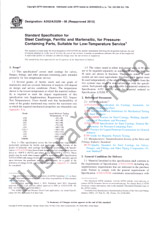Potřebujeme váš souhlas k využití jednotlivých dat, aby se vám mimo jiné mohly ukazovat informace týkající se vašich zájmů. Souhlas udělíte kliknutím na tlačítko „OK“.
ASTM D7991-15
Standard Test Method for Determining Aerobic Biodegradation of Plastics Buried in Sandy Marine Sediment under Controlled Laboratory Conditions
Automaticky přeložený název:
Standardní testovací metoda pro stanovení aerobní biologický rozklad plastů pohřben v Sandy mořském sedimentu v kontrolovaných laboratorních podmínkách
NORMA vydána dne 1.9.2015
Informace o normě:
Označení normy: ASTM D7991-15
Poznámka: NEPLATNÁ
Datum vydání normy: 1.9.2015
Kód zboží: NS-616775
Počet stran: 5
Přibližná hmotnost: 15 g (0.03 liber)
Země: Americká technická norma
Kategorie: Technické normy ASTM
Kategorie - podobné normy:
Anotace textu normy ASTM D7991-15 :
Keywords:
aerobic, biodegradation, marine, sandy sediment, tidal,, ICS Number Code 83.080.01 (Plastics in general)
Doplňující informace
| Significance and Use | ||||
|
5.1 Plastic is sometimes carried by rivers or accidentally discharged by ships into the sea; this plastic can then reach different parts of the marine environment. Tides and waves also frequently deliver plastic marine debris into the sandy tidal zones. 5.2 This test method simulates the environmental conditions found in the tidal zone. Plastic debris that reaches the sandy tidal zone can settle there and become partially or totally buried by sand and kept wet by waves or tides. It is of interest to assess the biodegradation behavior of plastic materials under these conditions to predict the removal time of this waste in the environment. 5.3 This test method is applied to determine the extent of biodegradation of a plastic exposed in the laboratory to a sandy sediment kept wet with seawater. Both sediment and seawater are collected from a sandy beach in the tidal zone. If the natural microbial population present in the sediment is able to biodegrade the plastic, there will be an evolution of CO5.4 This test method does not measure the amount of organic carbon that is converted into biomass, but only the biodegradation that leads to mineralization (that is, the formation of CO2). |
||||
| 1. Scope | ||||
|
1.1 This test method determines the biodegradation level of plastic materials exposed to laboratory conditions that simulate the environment found in the sandy tidal zone. 1.2 The tidal zone, that is, the part of the coast affected by the tides and movement of the waves, is the borderline between sea and land, frequently a sandy area that is kept constantly damp by the lapping of the waves. Stony and rocky shorelines also exist. 1.3 Plastic marine debris is frequently washed up in this habitat where it must be removed in order to restore the original landscape. 1.4 It is of interest to know the biodegradation behavior of plastics when exposed to conditions simulating this habitat, because this information can help in predicting the time needed for the biodegradation of the litter. 1.5 Biodegradation is determined by measuring the CO2 evolved by the plastic material when exposed to a sediment kept wet with salt-water in a reactor, to simulate the tidal zone. 1.6 Marine fresh-water habitats (for example, those found in brackish waters and estuaries) are not considered by this standard. 1.7 Reports shall clearly state the percentage of net CO2 generation for both the test and reference samples at the completion of the test. Furthermore, in the laboratory reports, the results shall not be extrapolated beyond the actual duration of the test. Note 1: There is no known ISO equivalent to this
standard.
1.8 Units—The values stated in SI units are to be regarded as standard. No other units of measurement are included in this standard. 1.9 This standard does not purport to address all of the safety concerns, if any, associated with its use. It is the responsibility of the user of this standard to establish appropriate safety and health practices and determine the applicability of regulatory limitations prior to use. |
||||
| 2. Referenced Documents | ||||
|
Doporučujeme:
Aktualizace technických norem
Chcete mít jistotu, že používáte pouze platné technické normy?
Nabízíme Vám řešení, které Vám zajistí měsíční přehled o aktuálnosti norem, které používáte.
Chcete vědět více informací? Podívejte se na tuto stránku.




 Cookies
Cookies
